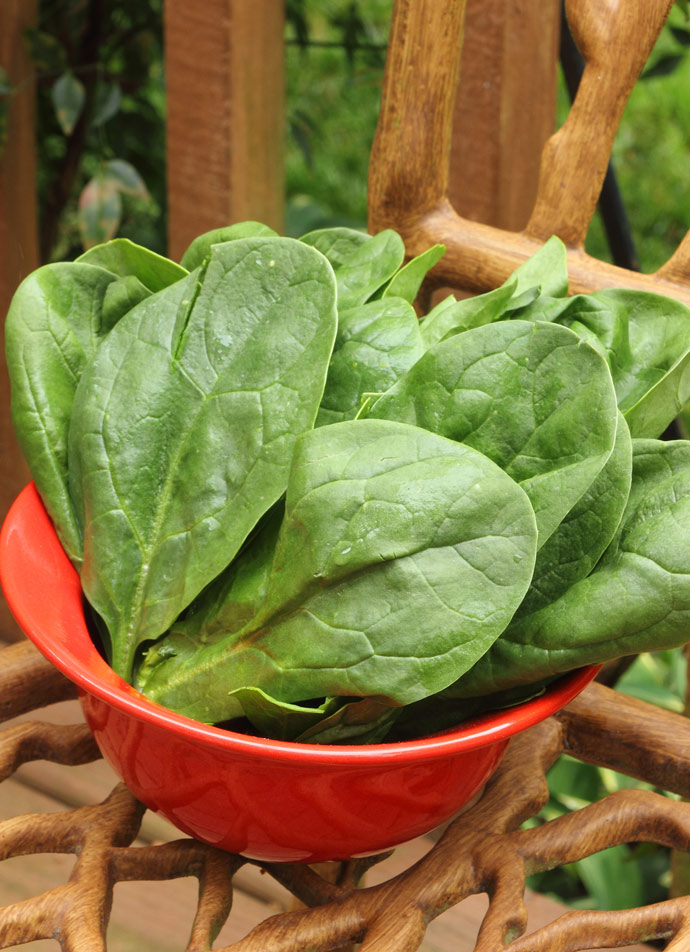Spinach is not only an easy vegetable to grow, but it is also a healthy treat low in calories and high in vitamin A, vitamin C, iron and calcium. However, besides being a beneficial edible, spinach has ornamental possibilities that should not be overlooked.
If you want to start spinach from seed, scatter them in the veggie patch around the middle of this month while the weather is still warm, to aid germination and enable the plants to reach a decent size before the first chilly winds of autumn. Liberally sow seeds a half-inch deep in rows one foot apart. When the seedlings appear, thin them to about six inches apart.
Using set plants instead of seeds will, of course, get the spinach crop off to a faster start, but there is one more advantage: Young plants can be strategically placed so their solid, constant green foliage infiltrates flower beds as a contrasting verdant backdrop for such favorite autumn ornamentals as dusty millers, gazanias, mums, marigolds, violas and pansies, to make their bright colors pop even more. Just remember that if you do interplant spinach with ornamentals, avoid using garden chemicals not recommended for veggies.
Like all leafy vegetables, spinach thrives on nitrogen. A simple sprinkling of common 8-8-8 or 10-10-10 at planting time, followed by an additional application in late September, should adequately encourage a bountiful fall harvest. And since spinach is sensitive to soil with a low pH — typical of Carolina clay — it wouldn’t be a bad idea to add a dusting of lime at planting time.
Fast-growing spinach needs plenty of water, so keep the hose handy if the rains don’t come. Also, mulch will help preserve ground moisture as well as prevent nutrient-robbing weeds.
A nd just what cultivar should you grow? ‘Bloomsdale Long-Standing’ is a fairly common selection that can be found in most garden shops. As an alternative, consider ‘Avon’ with its dark green, slightly crinkled leaves; ‘Space’, a vigorous-growing choice; or ‘Baby’s Leaf’, which produces lots of leaf and little stem. Gardeners who opt for smooth-foliage cultivars will find them easier to wash and prepare for meals than the wrinkled-leaf varieties (also known as Savoy) that have plenty of nooks and crannies for dirt, dust and six-legged critters to hide.
nd just what cultivar should you grow? ‘Bloomsdale Long-Standing’ is a fairly common selection that can be found in most garden shops. As an alternative, consider ‘Avon’ with its dark green, slightly crinkled leaves; ‘Space’, a vigorous-growing choice; or ‘Baby’s Leaf’, which produces lots of leaf and little stem. Gardeners who opt for smooth-foliage cultivars will find them easier to wash and prepare for meals than the wrinkled-leaf varieties (also known as Savoy) that have plenty of nooks and crannies for dirt, dust and six-legged critters to hide.
You don’t have to be in a hurry to harvest spinach before the first frosts because these hardy plants can stand temperatures down to 20 degrees F. Actually, a little bit of frost helps to sweeten the taste. As for picking spinach, pick often, and go for the outer, older leaves first.
L.A. Jackson is the former editor of Carolina Gardener Magazine. Want to ask L.A. a question about your garden? Contact him by email at lajackson1@gmail.com.
To Do in the Garden
August
- Beets, broccoli, cabbage, cauliflower, collards, kale, lettuce, mustard greens, radishes, spinach and turnips can also be planted now. For transplants, try to plant on a cloudy day and provide a little bit of shade during the worst of the afternoon heat for at least their first week in the garden. For seeds, rule No. 1 is never let the planting beds dry out.
- Gardeners, don’t forget thy warm-season veggies! You still have time at the beginning of this month to replant such fast-maturing summer vegetables as squash, cucumbers and tomatoes.
- Allow a few plants of such free-seeding herbs as dill, basil and chive to mature and produce seeds in the garden, which will readily re-sprout as volunteers in the garden next spring.
- Hollies and pyracanthas will benefit from additional waterings if the rains don’t come, because if stressed by hot, dry conditions, they could drop their immature berries.
- It’s bulb planting time. No, not tulips, daffodils and such, but rather fall-blooming pretties such as colchicums, sternbergias and autumn-flowering crocuses. Set in the garden now, they will quickly emerge, mature and flower in the waning heat of early autumn.
- It is not too soon to think about extending the fall garden — ever thought about making a cold frame? This easy-to-build structure will help protect propagated cuttings, pots of forcing bulbs and tender lettuce plants from early cold snaps.
- How easy is it to build a cold frame? For a simple, basic plant protector, just form five bales of hay into a horizontal “C” shape and cover it with a clear plastic sheet.
- It is also not a bad idea to think about starting a compost pile. Toss any grass clippings or spent plants into a bin or onto a pile and continue adding organic “fuel” through leaf fall in the autumn.
- Wash and refill the birdbath at least once a week. Also, after big rains, wipe down the bird feeder, as standing water in the tray can cause seed to spoil.
 Timely Tip
Timely Tip
Most roses — the main exceptions being many hybrid teas — will produce rose hips after their flowers fade. If these small fruits are clipped off, the plant won’t waste energy into their development, which would be at the expense of future flower production.
However, rose hips are not only edible but packed with vitamin C. Their tart flavor has often been used to add a tasty snap to teas, syrups, jellies and sauces, so think about allowing a few clusters to develop for culinary experimentation purposes — just be sure they haven’t been sprayed with pesticides.
If this first foray into using rose hips in foods has you hoping for more, consider planting a few Rugosa roses — they are the champs when it comes to producing impressive harvests of plump fruits.







